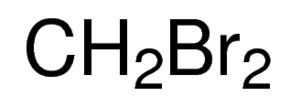Abbreviations DBMMDBUN 2664 Boiling point 96.95 °C Density 2.5 g/cm³ Classification Heavy liquid | Formula CH2Br2 Molar mass 173.83 g/mol Melting point -52.7 °C Appearance Colorless liquid | |
 | ||
Related alkanes | ||
Dibromomethane or methylene bromide, or methylene dibromide is a halomethane. It is slightly soluble in water but very soluble in carbon tetrachloride, diethyl ether and methanol. Its refractive index is 1.5419 (20 °C, D).
Contents

Preparation
Dibromomethane can be prepared from bromoform by reaction
CHBr3 + Na3AsO3 + NaOH → CH2Br2 + Na3AsO4 + NaBrusing sodium arsenite and sodium hydroxide.
Another way is to prepare it from diiodomethane and bromine.
Uses

Dibromomethane is used as a solvent, gauge fluid, and in organic synthesis. It is a convenient agent for converting catechols to their methylenedioxy- derivatives.
Natural occurrence

It is naturally produced by marine algae and liberated to the oceans. Releasing on soil causes it to evaporate and leach into the ground. Releasing in water causes it to be lost mainly by volatilisation with a half life of 5.2 hours. It has no significant degradating biological or abiological effects. In the atmosphere it will be lost because of reaction with photochemically produced hydroxyl radicals. The estimated half life of this reaction is 213 days.
